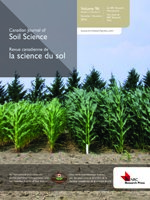Dampier, L., Sanborn, P., Smith, S., Bond, J. and Clague, J. J. 2011. Genesis of upland soils, Lewes Plateau, central Yukon. Part 2: Soils formed in weathered granitic bedrock. Can. J. Soil Sci. 91: 579-594. Polygenetic soils have formed on weathered granitic bedrock at high elevation (>1200 m asl) beyond the penultimate glacial limit on the Lewes Plateau in central Yukon Territory. Solum thickness in four Brunisols that were examined exceeds the depths of excavated pits (85-110 cm), but data indicate limited chemical weathering. Clay mineralogy is dominated by vermiculite and kaolinite. Smectite and chlorite are present in horizons derived, respectively, from residuum and colluvium. Sola are strongly cryoturbated, in spite of the lack of permafrost at these sites today. Three scenarios are proposed to explain these soils: preservation of relict soil features beneath cold-based ice, prolonged interglacial soil formation following erosion of till deposited by warm-based ice, and ice-free conditions throughout the Quaternary, with soil evolution shaped by multiple glacial-interglacial cycles.
How to translate text using browser tools
1 July 2011
Genesis of upland soils, Lewes Plateau, central Yukon. Part 2: Soils formed in weathered granitic bedrock
Lesley Dampier,
Paul Sanborn,
Scott Smith,
Jeffrey Bond,
John J. Clague
ACCESS THE FULL ARTICLE
It is not available for individual sale.
This article is only available to subscribers.
It is not available for individual sale.
It is not available for individual sale.

Canadian Journal of Soil Science
Vol. 91 • No. 4
July 2011
Vol. 91 • No. 4
July 2011
Brunisol
Brunisol
chicot
cryoturbation
cryotwbation
Lewes Plateau
plateau de Lewes




